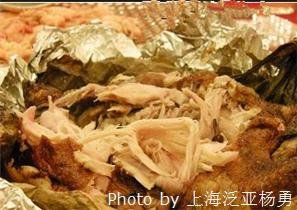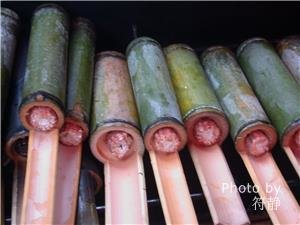Chinese pride themselves on eating a wide range of foods, and Chinese cuisine often has an interesting history. This article lists five unique Chinese foods, which you can taste when travelling in China. Although the Chinese restaurants in Doha have adapted to the local tastes, we bring to you some of the unique chinese dishes you can request next time you visit one.

 Bamboo Rice of Zhuang ethic group
Bamboo Rice of Zhuang ethic group
1. Beggar's Chicken (叫花鸡)

If you are planning to travel to Hangzhou, Beggar's Chicken is a highly recommended dish.
Features: It is a typical Zhejiang dish, with savory aroma and tender chicken meat. The chicken is served on a lotus leaf, and tastes fresher and less greasy.
Origin: Once upon a time, a beggar arrived at a village of Changshu Prefecture, Hangzhou. He had a chicken, and wanted to cook it. But he had no thing but a knife and a fire. He solved his difficulty by slaughtering and gutting the chicken, wrapping the chicken with yellow mud (without plucking it), and roasting the potato-like chicken. When he peeled off the dry mud, the chicken's feathers were also taken off.
Though the modern cooking of beggars chicken is largely identical to the beggar’s, it has been improved a lot, being much cleaner, more technical, and heathier.
Where to taste it: Beggar's chicken is widely served in Hangzhou’s restaurants. The best one for tasting beggar's chicken is Louwailou Restaurant (楼外楼), where it coats 168 yuan.
2. Bamboo Rice (竹筒饭)
 Bamboo Rice of Zhuang ethic group
Bamboo Rice of Zhuang ethic group
Bamboo rice is always cooked with rice and pork, which is cooked in a section of fresh green bamboo till the bamboo is seared. This food is delicious with the fresh fragrance of bamboo.
Where to taste it: Bamboo rice can be found in many places, especially where there are Dai minority and Yao minority people. Hence, you can have a taste when traveling to Yuannan Province(especially Xishuangbanna), Guilin (especially in the minority villages of Longsheng County), Guizhou Province (especially in the minority villages of Kaili), and Taiwan (Ali Mountain area).
Join one of our China minority discover tours to experience the colorful minority customs and relish their dishes with unique flavors.
3. Preserved Egg (皮蛋)
Shiny dark grey or black with s snowflake pattern, this unique egg product was created by Chinese people in the Ming Dynasty (1368-1644). Besides its unique taste, it is said that the preserved egg is useful for on curing hoarseness and dispelling the effects of alcohol.
Ways to eat: Many traditional Chinese restaurants serve dishes made with preserved eggs. Soup cooked with preserved eggs and mustard leaves (皮蛋芥菜汤), minced pork congee with preserved egg (皮蛋瘦肉粥, which can be found in KFC in China during breakfast time), and braised preserved eggs with tofu (皮蛋豆腐) are the most popular ways of eating preserved eggs.
Attention: Do not eat too many preserved eggs, especially children, because they may contain a little lead (like popcorn). Certified lead-free preserved eggs are available.










